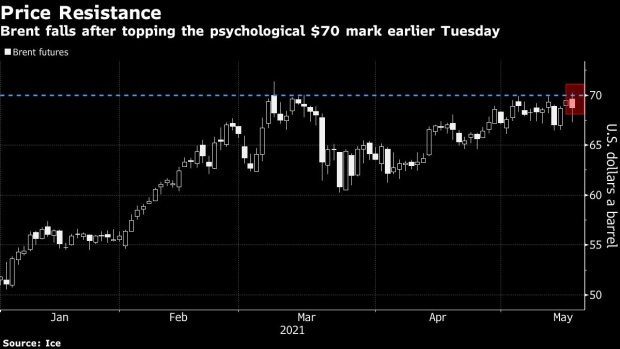May 18, 2021
Oil slips amid prospects of progress on Iran nuclear deal talks
, Bloomberg News
McCreath: WTI oil will pass US$70/BBL
Oil sunk as investors weighed developments in ongoing talks between world powers on a revival of the Iran nuclear deal, which would bring more supply to the market.
Futures in London fell 1.1 per cent on Tuesday after a Russian envoy in Vienna said significant progress has been made in efforts to broker an agreement between Iran and the U.S, the BBC Persian news channel reported. However, the same diplomat, Mikhail Ulyanov, subsequently took to Twitter to play down reports that a major announcement on the matter was likely on Wednesday.
“I said that significant progress have been achieved, in my view,” Ulyanov said in the tweet. “That is true. But unresolved issues still remain and the negotiators need more time and efforts to finalise an agreement on restoration of JCPOA.”
A return to the 2015 nuclear deal could allow for the removal of U.S. sanctions on the Persian Gulf country’s crude exports, raising the prospects of more crude coming back to the market. Iran has already been preparing to ramp up global oil sales, though the flow of additional crude may be gradual even if a deal is struck.

”The devil is in the details,” said Tom Finlon of Brownsville GTR LLC, a trading and logistics firm based in Houston. Despite “periodic comments on progress,” talks have been at “an impasse on substantive issues, so it’s not going to be that easy.”
Prices were already weak earlier in the session after Brent futures failed to sustain a rally past the key psychological $70-a-barrel mark, which it hasn’t closed above since May 2019. Meanwhile, concerns are lingering around the worsening COVID-19 crisis in India. The South Asian country’s gasoline exports soared 85 per cent in the first half of May from the same period last month, according to Vortexa, as fuel sales there wane.
Prices
- West Texas Intermediate for June delivery traded at $65.26 a barrel as of 4:51 p.m. in New York after settling at $65.49 a barrel
- Brent for July settlement lost 75 cents to end the session at $68.71 a barrel
Futures clung to losses in after-market trading following the release of the industry-funded American Petroleum Institute’s inventory data, which showed that U.S. crude inventories rose by 620,000 barrels last week. If confirmed by U.S. government data on Wednesday, that would be the first weekly increase in three weeks. The API report also showed declines in both gasoline and distillate stockpiles.
Despite crude’s decline on Tuesday, oil is joining other commodities in a blistering rally this year. Crude prices are up more than 30 per cent as raw materials emerge as a hedge against inflation. Much of Wall Street is calling for higher prices, with Goldman Sachs Group Inc. talking up the prospects of $80 a barrel oil. At the same time, the Organization of Petroleum Exporting Countries and its allies are boosting supply to meet rebounding demand.
Meanwhile, the largest U.S. fuel pipeline restored a vital communications system after an outage earlier Tuesday temporarily left customers in the dark about fuel shipments. The Colonial Pipeline has been trying to recover after a cyberattack more than a week ago caused a spate of panic-buying at gas stations across a dozen states.
Other oil-market news:
- The world has a choice -- stop developing new oil, gas and coal fields today or face a dangerous rise in global temperatures, according to the International Energy Agency.
- Nigeria is encouraging Royal Dutch Shell Plc to keep its onshore oil and gas business in the country instead of divesting it, as the company seeks to focus more on cleaner energy and offshore production.
- The shale industry, much maligned by investors for excessive spending without returns to show for it, has managed to resist a 22 per cent run-up in oil prices during the first three months of this year, holding output almost flat.





